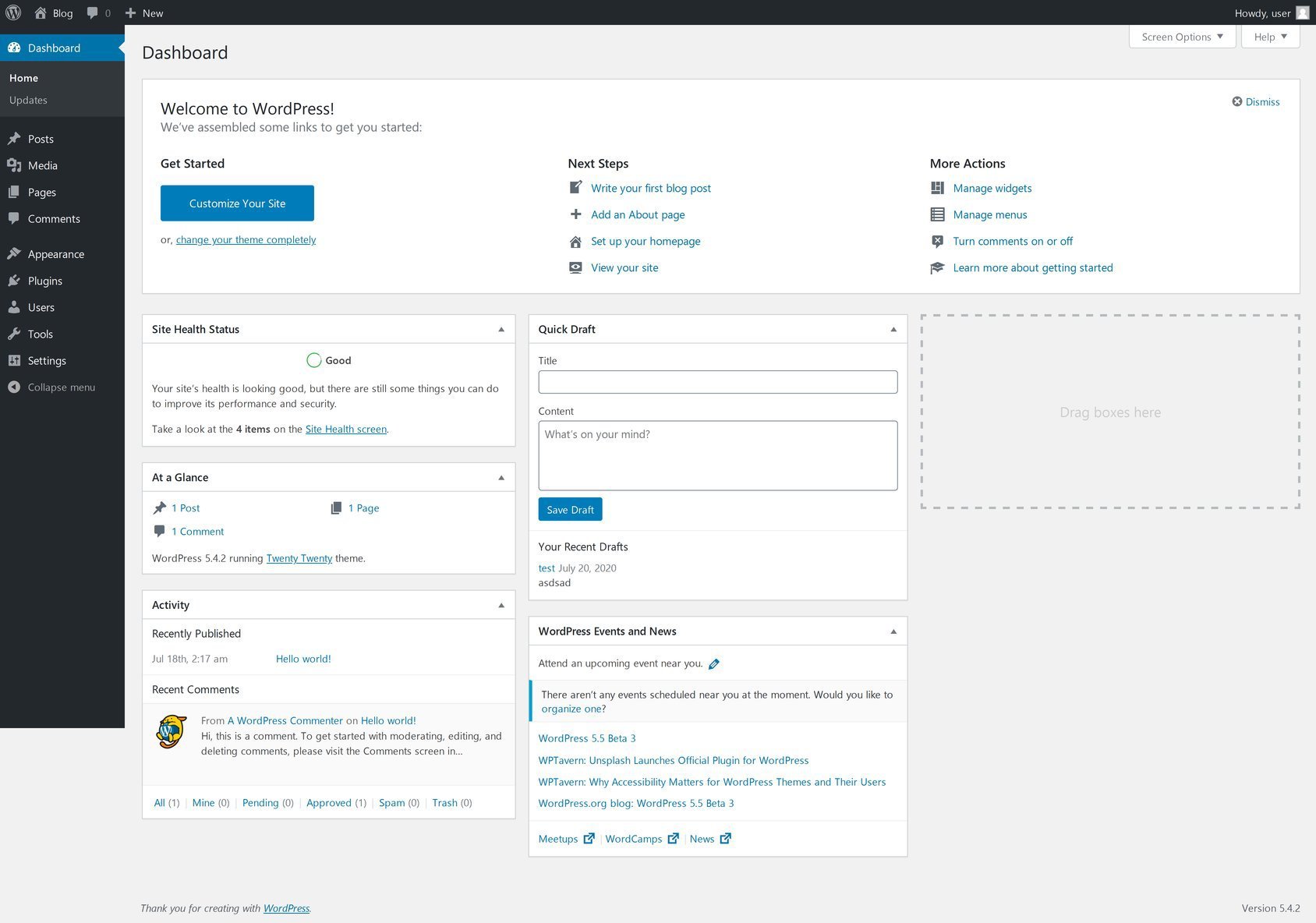welcome to wordpress Dashboard !
When a user logs in to the admin area, the WordPress dashboard displays a quick overview of the blog or website. The Dashboard allows you to post articles, add plugins to enhance the website’s functionality, add categories, customize themes, and more.
Often known as WP Admin, the Dashboard is the control center of your entire blog/website. It is where you can customize settings, manage content, and change styling. If you’re a beginner, it’s essential to learn how a user can access wp-admin, how a user can effectively control and modify their site through wp-admin, and many other uses.
In this article, you’ll learn about the Dashboard screen options, the tabs that you see on the WordPress Dashboard menu, how a user can log in to the WordPress Admin area, how to change site colors, how to update your profile in the admin area, and how can you change the Dashboard themes and layout.
How to log in to your WordPress website
How do you log in to the WordPress admin panel? To access the WordPress admin panel, or the Dashboard, you must log in to your WordPress website. To access the login page, add /wp-admin or /wp-login.php to the end of your domain, for instance, abc.com/wp-admin or abc.com/wp-login.php. Once on the login page, enter the username and password you selected while installing WordPress on your website. Now, click on the login button. After logging in successfully to the WordPress admin panel, you will see a screen with widgets, blocks, and menus. This is your Dashboard Main Screen.
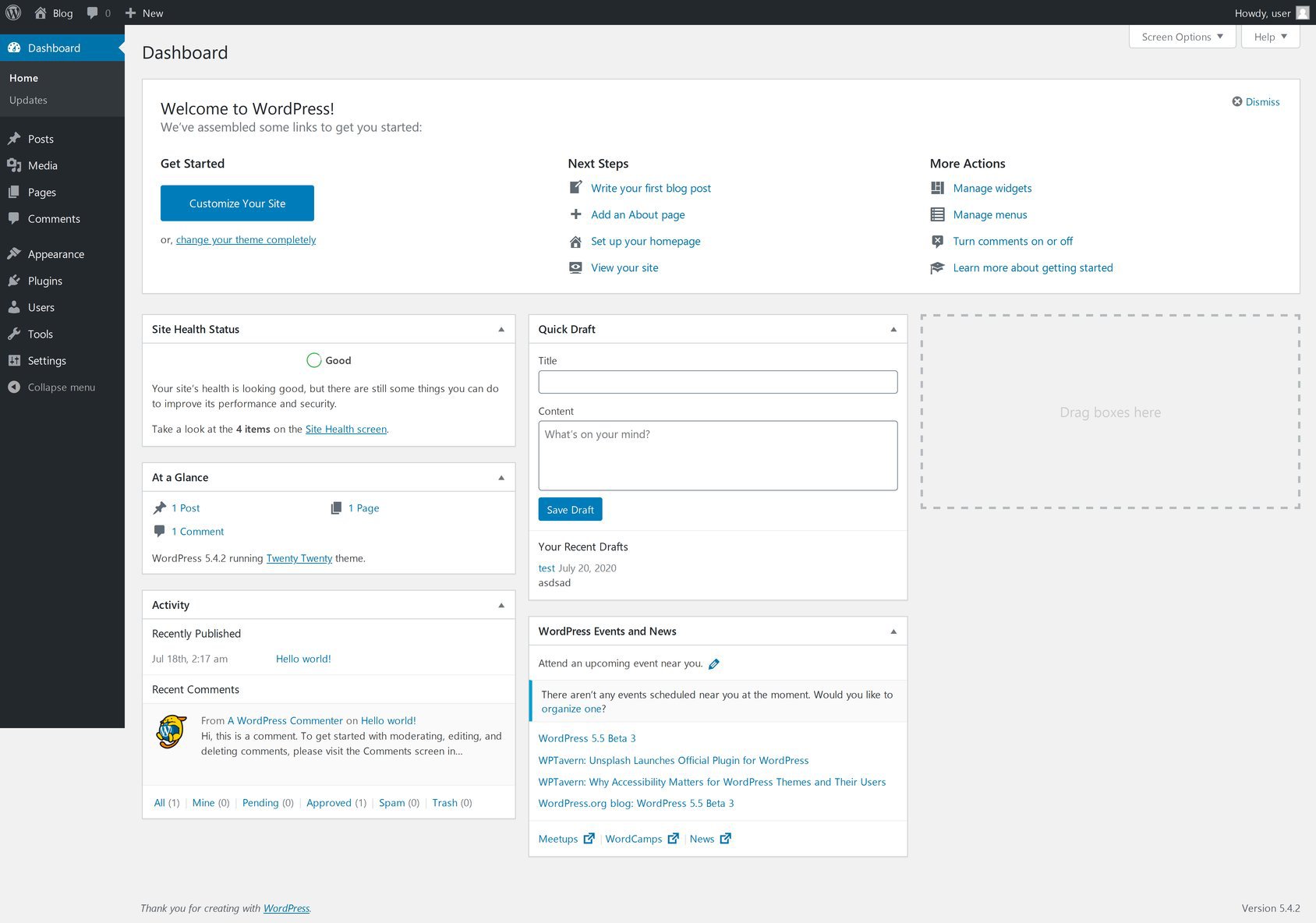
Dashboard – main screen
The WordPress Dashboard is the first screen a user sees after successfully logging into the admin portion of the website. It is a collection of widgets, elements, and menus that help manage your website content, present various information, and display a quick overview of your website’s functions. From within the dashboard screen, hover your cursor to navigate different site sections quickly.
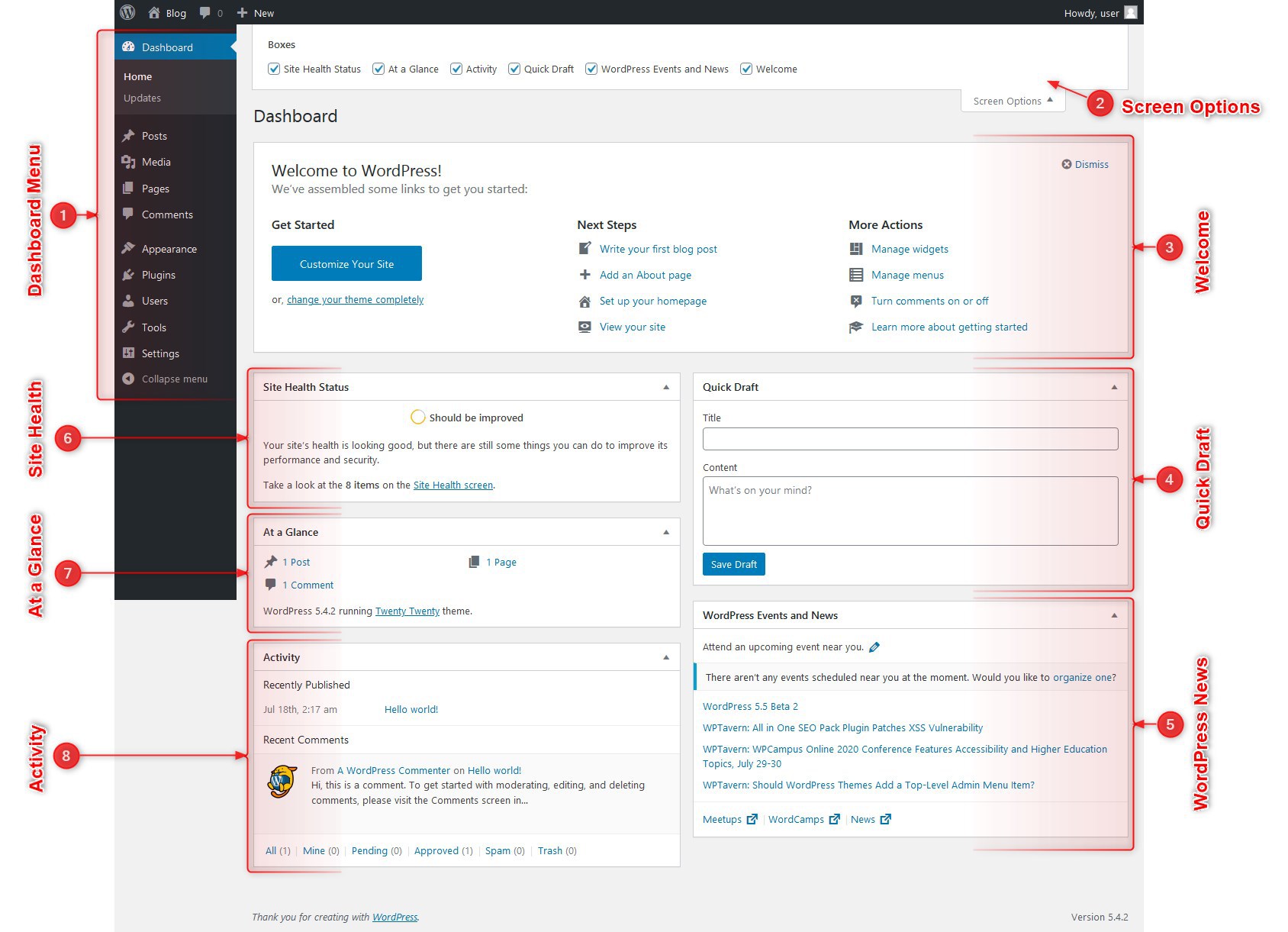
Now, let’s explore the different components of the Dashboard main screen.
1. Dashboard menu
The WP admin Dashboard shows a navigation menu on the left side of the screen. This menu comprises different options: posts, media, pages, comments, an appearance tab, plugins, users, tools, and settings. With the Dashboard menu, you can quickly navigate and manage different sections of your website.
2. Screen options
By default, WordPress shows six widgets on the WordPress admin panel. They are: “Site Health Status,” “At a Glance,” “Activity,” “Quick Draft,” “WordPress Events and News,” and “Welcome.”
“Screen Options” allows you to display or hide these widgets on the admin screen with one simple click. To view a widget, check the box in front of the widget name in the screen options area. Similarly, uncheck the box before the widget name to hide a widget.
3. Welcome to Dashboard
The Dashboard Main Screen has three columns. The left column includes the “Customize Your Site” button, which allows you to customize your site or change your theme settings completely.
The center column provides links for writing your first blog post, creating an about page, setting up the home page, and viewing your website’s front end. The column on the right provides valuable links to manage widgets and menus, settings related to comments, and links to the WordPress setup guide.
4. Site Health Status
This widget helps site owners to monitor their WordPress website’s speed, performance, and security. Site Health allows users to identify issues and assists them in fixing those issues. Site Health scores your WordPress health after running a series of tests. It rates the results with three labels (Good, Recommended, and Critical). When you click on the “Site Health screen, you’ll see two pages (Status page and Info page) that show your website’s results and statuses.
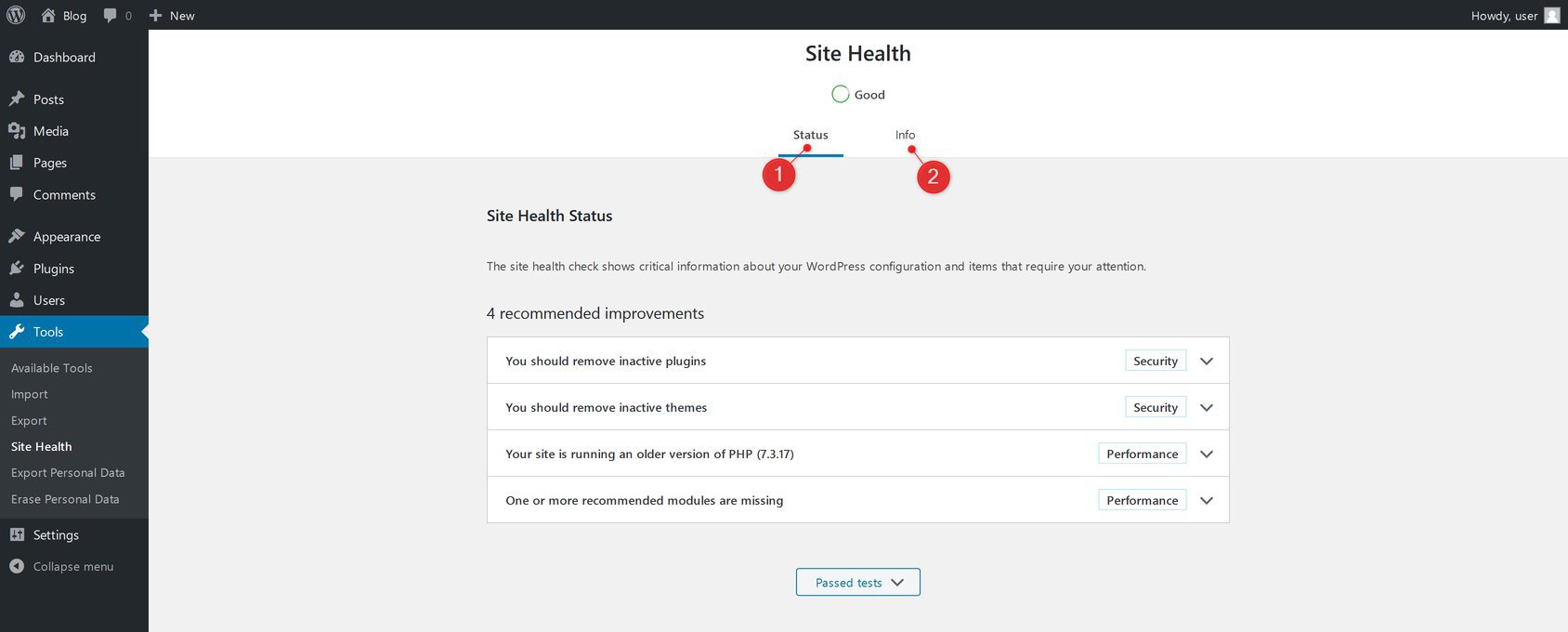
If you’ve passed the tests, your site health will be labeled “Good.” If you see “Recommended,” it means some changes are required, but not necessary. If you haven’t passed the tests, your site health will be labeled “Critical.” It means there are some significant issues that you must consider fixing immediately.
5. Quick Draft
Quick Draft is a mini post editor allowing you to create a draft for your new website posts quickly. To make a quick draft, enter the title and content. Then click on the “Save Draft” button, and the post will be saved as a draft, which you can edit later from the “Posts” section. Recent drafts will also be shown in the “Quick Draft” widget.
6. WordPress news and events
This widget displays the latest news and events about WordPress, such as the new updates, alerts, upcoming events, and meetups shared from the official WordPress blog.
7. Activity in Dashboard
This block shows recently published posts and the latest comments on your blog. It also gives you quick links to go to different comment sections so that you can approve, reply, edit, spam, or trash comments, all at the bottom of the widget.
8. At A Glance Dashboard
The “At A Glance” section summarizes your site’s published blog posts, pages, and comments. You’ll be taken to that specific screen when clicking the individual links. “At A Glance” also shows the current version that you are running of WordPress, as well as the active theme selected for your site.
9. Toolbar
The Toolbar is displayed at the top of each Admin Screen. It has links to functions such as adding a new post, seeing pending comments, and editing your profile. Many Toolbar items expand when you hover your mouse over them to display more options.
What options do you see on the Dashboard menu?
The WordPress Dashboard provides a navigation menu on the left side that contains options for posts, media libraries, pages, comments, appearance options, plugins, users, tools, and settings. This is where you’ll update and configure your site using different options.
Your Dashboard makes it convenient to customize your website’s settings with a few clicks. It lets you manage different site sections and change the entire look by changing the theme or adding new functionalities via plugins.
Now, let’s take a look at each menu option briefly.
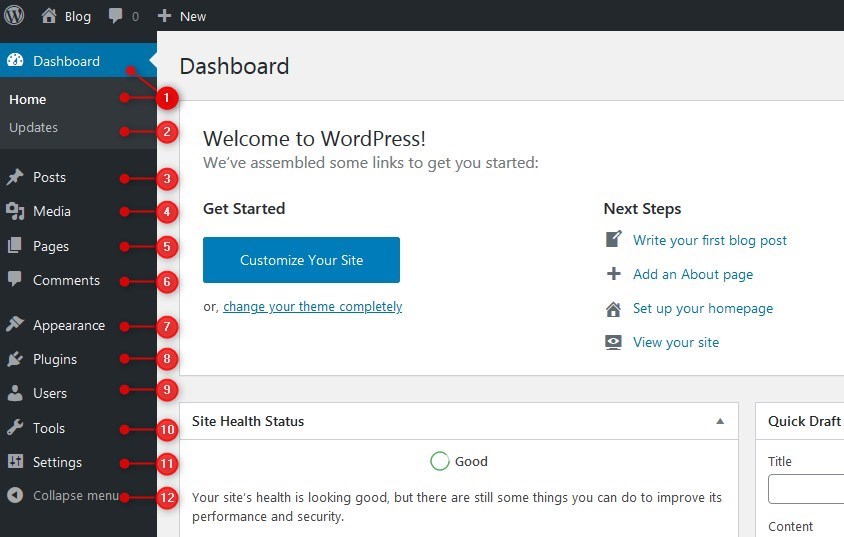
The WordPress Dashboard Menu options are listed below:
1. Dashboard or Home
When you click on your Dashboard, it will display the Dashboard’s “Homepage,” which is your WordPress admin screen, as discussed earlier in this article.
2. Updates
The “Updates” section will notify you if any updates are available for your WordPress, such as installed themes or plugins. It will update them from within the “Updates” section. You can also update the themes and plugins from their respective sections, but you have to do it from the “Updates” section to ensure that the WordPress version is updated.
3. Posts
This is where a WordPress user can view their posts, create new blog posts, edit old posts, delete posts, and manage categories and tags.
4. Media
Media Libraries allow you to upload new images, documents, and files to your WordPress website. You can view, edit, and update the media library files uploaded within the “Media” section.
5. Pages
Click on this menu option to view all the pages created on your website, create new pages, update your existing pages, or delete pages.
6. Comments
This tab shows the latest comments on your blog posts. It allows you to approve, reply, edit, mark spam, and trash comments. WordPress users can manage all their website comments from within this menu.
7. Appearance
This is the most crucial menu option for customizing settings, managing widgets, changing or editing a theme (Theme Editor), and changing the background image on your site.
8. Plugins
Plugins add or enhance the functionality of your WordPress website. This menu option shows installed plugins on your site. It lets you add or delete plugins, edit installed plugins, and activate or deactivate plugins.
9. Users
The “Users” menu option shows all of the existing users of your website or blog. You can also add new users, edit user settings, delete a user, and manage users’ roles based on their responsibilities.
10. Tools
This menu option allows a WordPress user to import data from platforms like Tumblr, RSS, and LiveJournal. Similarly, you can also export the data from your WordPress website. Users can also erase personal data from the WordPress site or export personal data. This menu option lets Site owners monitor their WordPress website’s performance, security, and speed. Site Health assists users in identifying site issues and helps them fix those issues.
11. Settings
The settings tab allows users to configure their site. With this option, you can customize your site title and URL, set default user roles and identities, identify the page where your latest posts should appear, moderate comments, and much more.
12. Collapse menu
At the bottom of the WordPress Dashboard menu, you will see an option named “Collapse menu.” Clicking this option will hide the menu item names and display the menu item icons. Click again to expand the menu.
conclusion
The WordPress Dashboard is the indispensable command center for your entire website. This guide has provided a comprehensive tour, starting from the simple login process to a detailed exploration of the main screen’s key components, such as the “Site Health” monitor, the “At a Glance” summary, and the convenient “Quick Draft” tool.
By delving into the primary navigation menu, you’ve seen how every aspect of your site—from creating posts and pages to managing media, comments, plugins, and themes—is readily accessible. A thorough understanding of the Dashboard and its extensive settings is the first and most crucial step in effective website management. Mastering this powerful interface empowers you to fully control your site’s content, functionality, and design, enabling you to build and maintain a professional and dynamic online presence.
